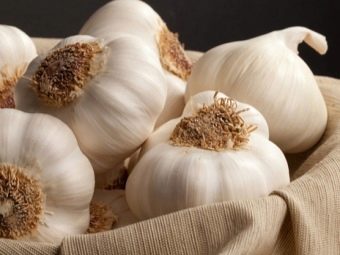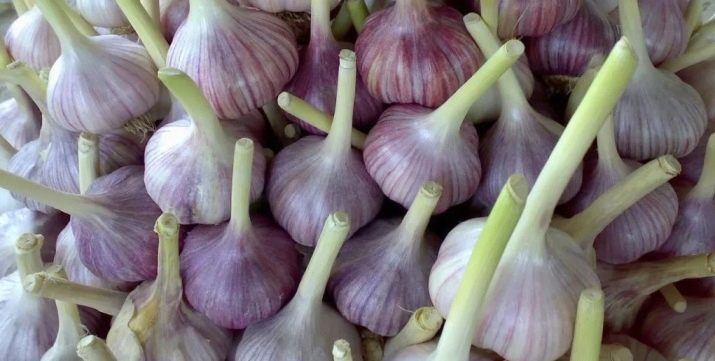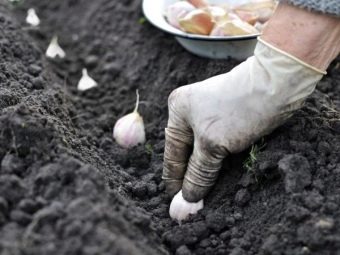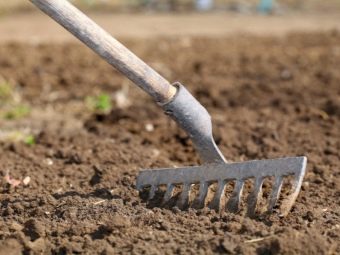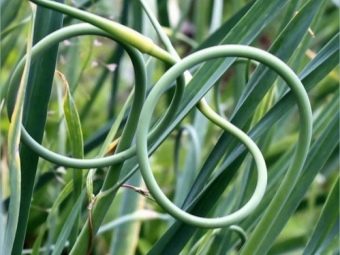Planting garlic in the fall and caring for it
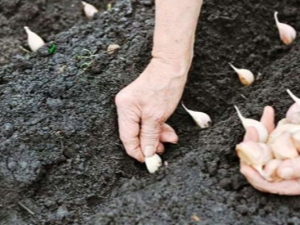
Every gardener, whether professional or amateur, is well acquainted with such an ancient culture as garlic. For a long time, this vegetable has been attributed a magical effect, a property to cast out vampires, a strong healing effect. Some people used it as an aphrodisiac, others - as an analogue of modern antibiotic. Numerous beneficial properties of garlic, its healing power and versatility of use remain unchanged.
Garlic is cultivated on the traditional six hundred square meters for many decades in a row. Any of the summer residents have their verified secrets of growing this vegetable. Yet every year they turn to the advice of experienced gardeners to increase the yield of this vegetable.
What is different from the summer?
If you want to get a vegetable with a rich sharp taste and high bactericidal properties, then the choice falls in favor of winter varieties. They give a large head with large teeth. Plants become more enduring, better tolerate bad weather conditions. An important advantage is the earlier harvest. As a rule, garlic ripens and ready for harvest in early August.
There is a logical question about how to distinguish between winter and summer varieties for planting. Make it a snap. The head of winter garlic is usually made up of 4 to 12 large teeth, which are located in one row around the thick stem. They are covered with a light purple shell. The taste of such garlic is more spicy. For cooking and canning it is used in summer and autumn. Such an August harvest is also good as a seed for the new season. The disadvantage of such varieties is that they do not have good keeping quality.
The head of the summer variety has several rows of small teeth (about 25 pieces), the main solid core is missing. They taste softer, with less pronounced sharpness. The advantage of spring varieties is their good preservation. Such garlic is edible throughout the winter.
Advantages and disadvantages
An increasing number of gardeners choose autumn planting of garlic because of the many obvious advantages. Among them are such as:
- increased yield compared to spring;
- low susceptibility of winter garlic to diseases and pests;
- early harvest;
- excellent resistance of winter plants to temperature changes and the vagaries of spring weather;
- lack of care in the spring and summer;
- rich spicy taste.
Sowing garlic before winter has its drawbacks. They consist in the possible improper deepening of the bulbhobes and non-observance of the landing dates. If you disembark too early, you will get a well-grown root system. This, in turn, will lead to the germination of the green aboveground part.
At the first frost, such plants may die. If the teeth are planted too late, the roots will not have enough time to form.
Variety selection
The variety of garlic varieties on the market today is very large. It's hard not to get lost in all this variety. But all varieties are divided into two types: forming an arrow and non-arrowing. The latter cause less hassle for gardeners, since there is no need to waste precious summer hours to remove the shooters from them.
An important criterion in the selection of varieties is the climatic zone under which the crop will be grown. Planting time, winter shelter methods, spring cultivation, harvesting period and its preservation depend directly on this.
Among non-strepled varieties are popular:
- Variety "Autumn" - bred in Western Siberia, has a good winter hardiness, high yield. Maturing term - 3 months.
- Garlic "Belarusian" has an average productivity, but good winter-resistance, is stored for a long time. Suitable for lovers of pronounced sharpness in taste.
- Variety "Triumph" will appreciate the high yield and burning taste. Will be stored until early spring.
- "Sail" is one of the most popular high-yielding varieties, resistant to most diseases. Suitable for fans of seams and adzhika.
- "Purple Kharkov" Bred in Ukraine, suitable for the southern regions. Maturation term - 4 months. Garlic is appreciated by lovers of hot spices for a very hot taste.
- "Gribovsky anniversary" possesses high productivity. Large-sized heads will retain freshness for a long time. It withstands drought well and has a high frost resistance.
- Sort "Doctor" those who do not like too sharp taste will appreciate. Of the advantages of the form - a high yield, the ability to store up to 7 months.
If the main criteria for choosing a variety are yield and endurance to the weather conditions of the middle lane, then you can pay attention to the following gardeners' favorites:
- Variety "Reliable" appreciate for good preservation, the heads will be stored until the next harvest. The severity of the variety is moderate.
- "Moscow Region" specially created for the conditions of the middle zone and areas of risk farming. It is distinguished by such qualities as stable high yield, frost resistance, resistance to diseases.
- "Dobrynya" - it is a late ripening variety with good keeping quality. It gives a high yield and is a universal variety that allows its use in different climatic zones.
- "Novosibirsk" variety will be appreciated by those who prefer mild sharpness in taste. The variety has high yields, tolerates frost well. Stored up to six months.
- "Scythian" - This is a relatively young variety, bred specifically for Siberia. It shows itself well in other regions. It is distinguished by excellent resistance to disease, unpretentiousness to weather conditions.
- "Spas" - high-yielding variety of garlic, not prone to disease. Will delight gardeners long shelf life. High frost resistance makes it an ideal crop for many regions.
- "Komsomolets" - a frost-resistant unpretentious grade possessing good resistance to diseases. He is loved for undemanding care and a pleasant pungent taste.
- "Alkor" suitable for lovers of spicy taste. Stable rich harvest, excellent preservation of heads and frost resistance of this garlic variety are time tested.
Foreign varieties are also interesting, which are suitable for native beds due to their hybrid properties.
The variety "Lyubasha" is bred in Ukraine, the mass of the head often exceeds 100 grams. Resistance to diseases and good safety of the crop have long been loved by connoisseurs of this variety.
Hermidor is a Dutch hybrid ripening in June. Of the merits of its good immunity, frost resistance, high yield. The variety is well kept, suitable for both home canning and for fresh consumption.
When choosing a variety for planting, you should choose for yourself two main criteria, for example, keeping quality and yield or bright spicy taste and fast ripening periods. As can be seen from the characteristics of the varieties, it is almost impossible to obtain all the required qualities at once.
In addition, the way the plants show their desired qualities depends on the soil properties, wintering conditions, abundance of rain, the number of sunny days, compliance with the technology when harvesting winter vegetables and a number of factors.
When and how to plant in the winter?
The choice of the method of growing garlic is always yours. You can begin to grow it in the spring, and you can fall. Both methods are known and give very remarkable results. Each of them has its advantages and disadvantages. However, there are some of the most common recommendations for cultivating winter garlic that everyone should remember.
In the cultivation of a number of plants, the time in which it is planted on the garden bed is of paramount importance. On this depends on the abundance of the crop and whether it will be at all. Garlic is no exception. The dates are largely correlated with the climatic conditions of each particular region.Should be guided by the average time of onset of constant frosts. Affects the timing of the landing and the estimated depth at which the teeth will be buried.
If you are going to plant in the garden or cottage garlic, you will need to take care of this in the last summer month. Planting suitable varieties for the winter will give you a high viability of spring shoots and large heads of this sharp vegetable.
If you want to deepen slices of garlic no more than 3-7 centimeters, then planting should be carried out no later than 3 weeks before the onset of early autumn frosts. In areas of a temperate climate in Russia, the period from the last week of September to the second week in October is considered as such a time. In the southern zones with a predominance of a mild climate this will be November.
By planting seedlings up to 5 centimeters from the 20th of September to the 10th of October, you ensure good rooting of your crops. At the same time green shoots will not germinate through the soil.
Among the latest trends in the cultivation of weed can be noted planting it at a considerable depth. This method gives the best rooting, the plant is better tolerated severe cold.
Sowing the cloves of garlic deep into the beds from 10 to 16 centimeters in the mid-latitude strip can begin as early as the end of August and continue until the twentieth of October.
Orientation of garden work on the lunar seeding calendar is becoming increasingly popular. The most common are the tips on landing a bulbous on a waning moon. If you decide to plant garlic on a full moon day or on a growing moon, it is better to postpone planting for several days. In the first half of the moon cycle, the juices in the plant rise from the bulb up the stem, which promotes the growth of greenery. In the autumn, the most important thing is to form a root system at the bottom of the set.
There are recommendations regarding the characteristics of planting garlic in certain geographical and climatic regions of Russia. Thus, in the central zone, the beds are covered 2 weeks before cooling and the appearance of snow cover. Garlic coating is not removed, especially in the winter with little snow: this will save the future harvest from frost.
In the Urals, they do not recommend mulching a bed in the autumn, but it is necessary to do it in the spring. Frequent changes in temperature, the instability of the weather does not allow to regularly loosen the landing. Spring mulching helps to solve this problem: the root system will not be damaged, and at the same time the plant will not suffer from a lack of nutrients.
The harsh climate of Siberia makes its own adjustments. Frosts here can begin as early as September, therefore the landing is scheduled for the beginning - the middle of September. The beds must be well mulched and covered, as frosts can occur long before the appearance of constant snow cover.
Everyone knows about the importance of crop rotation, which gives an increase in yield, a decrease in some of the characteristic diseases of the plant. It is better if plants of the legume family, cabbage, zucchini, pumpkins, berry bushes, cucumbers, peppers, eggplants, and some cereals grew on the garden before garlic. These vegetables are very demanding on the concentration of soil nitrogen.
An important rule to remember when growing such a very valuable crop is in no case plant garlic on a plot of land where onions and garlic were previously grown. Onions depletes such an important trace element in the soil as potassium, which is essential for garlic. In addition, onion diseases can easily spread to his closest relative in the family.
Do not recommend planting garlic on the ground, where before there were roots (carrots, beets, potatoes).
Many gardeners know that a neighborhood has a good effect on one bed of garlic and strawberry. With this planting, you solve several problems at once: save both plants from diseases, increase crop yields and save crop areas on the site.
If, nevertheless, there is no possibility to carry out crop rotation, then after harvesting and before planting a new one, Victoria should be planted in the garden.It fills the earth with nitrogen. It is also good to use white mustard for this purpose. It saves the earth from many diseases and is an excellent sideratom for many cultures. Sowing mustard in the garden before planting vegetables increases the fertility of the soil, provides a powerful drainage layer and improves moisture permeability to the roots. If there is such an opportunity, then before planting winter teeth on the future garden bed, green manure is grown in the spring. After ottsvetaniya dig up their land no more than 15 centimeters.
Plot under the bed of garlic should be fairly well lit. The soil is preferably weakly acidic, light, fertile. In the soil should not be fresh manure. It will not serve as a good fertilizer for garlic, but will only lead to various diseases and may cause the process of rotting of the bulbs. Manure is made at least three years before preparing the land for garlic. It is better if the land is not too light, otherwise from the heavy rains the cloves of garlic can get too deep. Very heavy soil is also bad, as it can push the plant up in winter, leading to freezing and planting death.
Seat preparation includes fertilization with subsequent digging, as well as treatment for diseases and pests. They make a bed about a meter wide and are located from north to south. If the soil is still sour, you will help making 200-300 grams of lime per square meter of beds. If the soil is too heavy, add river sand. If on the site the soil is excessively loose, then its fertility is increased by adding humus (about a bucket per square meter). Clay and loam are also added.
For fertilizer, a mixture of 10 kg of humus, 2 glasses of ash, 2 tablespoons of potassium sulfate and 2 tablespoons of superphosphate is added to each square meter of bed. Having distributed this mixture over the ridge, they dig up the earth on the bayonet of the shovels in depth (15-20 cm). This procedure is usually carried out 14 days before planting seed.
For a better drawdown and disinfection of the soil it is poured over with a solution of manganese or 1% solution of copper sulfate (1 tablespoon diluted in a bucket of water). The resulting solution from the watering can well spill the entire surface of the earth.
Layout beds for planting garlic teeth is quite traditional. The height of the beds should reach 25 centimeters. The bullets should be planted correctly according to the 10-25 scheme: the distance between the rows is 20-25 cm, 10 cm between the teeth are kept. The garlic cloves are placed at a depth of 3 to 15 cm in accordance with the selected planting method. If the ground is too wet, it is recommended to pour a 1.5-centimeter layer of dry sand at the bottom of each groove. This method will prevent excessive contact with the wet soil and protect them from rotting.
Prepare garlic before planting. Novice gardeners usually take smaller seeds for planting, acting on the principle of selecting potatoes for planting. To get a good harvest, it is important to choose the largest and most healthy heads without visible signs of damage, stains. To do this, each head is divided into teeth, necessarily removing the bottom with the roots. Then the teeth are soaked for two hours in a weak solution of potassium permanganate. For processing use and a two-minute soaking in a solution of copper sulphate, adding one teaspoon of the substance to 10 liters of water.
The place where the garlic will be planted should be sufficiently dry, but at the same time there should not be very intensive to melt the snow in the spring. An ideal bed would be where there is enough sunlight, there is no possibility of people or animals trampling the seedlings, moisture is retained in the spring and there is an ice crust on the ground. Such a place could be the north side next to the fence.
Do not plant garlic in one place two times in a row. This will significantly reduce the yield and lead to the reproduction of putrefactive microorganisms in the soil. It is recommended to plant the plant in one place no more than once every 4 years.
When folding cloves of garlic in the wells do not push them into the ground. So you can damage them, which will cause delayed root formation.
If you cut a clove of garlic across, you will see a teardrop shape. One sidewall will be round or oval, while the other will be with an edge (rounded corner). When planting garlic, the angular side is oriented north-south. This method gives an increase in the size of the heads.
To close the hole suitable dry rotted compost. Watering the garden is no longer necessary. If the ground is very dry and there has been no rain for a long time, you can shed the holes with a weak solution of manganese before planting garlic.
From above we mulch a bed with peat, fallen leaves or coniferous spruce leaves, if there is such a possibility. Recently, some gardeners use non-woven covering material to preserve winter garlic (spunbond). To do this, take a piece the size of a little larger than the perimeter of the bed (about 20-30 cm on each side). Put it on top of the compost, pressing the edges with scrap materials. To do this, fit bricks, stones, any small heavy objects in the garden.
How to care?
Even if the vegetable survived the winter successfully, unfortunately, due to the frequent weather surprises, it does not happen that garlic has risen all. This happens even with the proper observance of agrotechnics, so you should not blame yourself. The output will serve as a spring transplant of garlic.
It is usually produced in April or May, when it is already visible where there are no shoots on the garden. General recommendations for spring transplantation are generally the same as in the autumn. The plot should be dry and sunny, rather high, with fertile soil. Useful neighbors will be beans, strawberries, cabbage and radishes. Neighborhood with onions should be avoided.
To transplant winter garlic with formed roots and greens is necessary only in light soil. To do this, they dig up the land at the site, loosen it with forks, water it in advance. The land is necessarily fertilized. The most commonly used for this is wood ash, azophoska, and potassium magnesia. Fertilize the bed before digging, strictly focusing on the dosage recommended by the manufacturer. Charcoal contribute in the amount of 1 kg per 1 square meter. On the new garden plan rows and holes. The interval between the rows is 30 cm, between the holes - 10 cm. The garlic is sunk by no more than 10 centimeters.
Overwintered garlic is dug very carefully with a small heart-shaped shovel. It is deepened into the ground within a radius of 5 cm from the shoot. Gently pull up the sprout, while undermining the root. Garlic with earth lump transferred to the new ridge. Without strong pressure, they are planted in holes, covered with earth. Top rows need to pour water.
If you did everything right, the plant will take root in a week. You can determine this by the growth of the aerial part.
A little more care is needed for garlic, so transplanted in spring. It consists in feeding, watering and regular loosening. From time to time garlic need spud. First of all, the winter mulch layer is removed. So you facilitate the germination of garlic. At the same time, rows with planting can be powdered with ordinary ash. It will serve as an excellent mineral fertilizer, as well as protect young shoots from many diseases and pests.
Young sprouts need sufficient watering, especially after a snowless winter. Over time, watering is reduced and minimized so that the heads of garlic do not rot. Under normal weather conditions, watering garlic is not required in summer in the middle lane. In dry weather with a long absence of precipitation during the growth and maturation of the heads, the plant is watered twice a month.
After winter, the soil is well fertilized, the volume of your harvest at the end of summer will depend on it. Fertilizer is applied three times per season with an interval of 1.5-2 weeks. In spring, the plant releases the first leaves, and when their number reaches 4-5 pieces, they carry out the first feeding.To do this, a tablespoon of urea (ammonia) and a tablespoon of complex mineral fertilizer (nitroammofosk) are diluted in a bucket of water. The consumption of such fertilizer is 3-4 liters per square meter of sowing.
After 2-3 weeks produce the following feeding. To do this, take 2 tablespoons of nitrophoska and dissolve in 10 liters of water and well shed rows with garlic.
At the end of June - the beginning of July, but no later than 3 weeks before the ripening of garlic, produce additional fertilizing with a solution of superphosphate. In 10 liters of water dissolve 2 tablespoons of the substance. Consumption at the same time will be 4-5 liters per square meter.
Do not forget about the removal of arrows, which by the end of June tying the plant. They do this when their length reaches 10 cm, pinching at the very base. This allows the bulbs to fill better and grow larger. Otherwise, a significant portion of the nutrients will go to the inflorescence.
Do not rush to throw arrows. They are used in the preparation of various sauces, side dishes, pickled, frozen for the winter and just consumed crushed in fried.
An important role is played by periodic loosening. It is desirable to do this at least once a week, and better after each heavy rain and watering. Loosening the soil ensures proper air circulation, due to which the plant is better supplied with nutrients. Also reduces the risk of infection with fungal diseases, rotting bulbs.
From pests, garlic is treated with standard insecticides and fungicides by spraying or root treatment. This procedure does not affect the taste and keeping quality of garlic.
When to dig?
Harvesting is carried out in dry weather in late July - early August. When the lower leaves turn yellow and fall, you can dig out the garlic, gently pulling it out by the tops and helping yourself with a small spatula. Compliance with the collection time is no less important than the correct landing time. If you perederzhat plant in the garden, the head cracked, may rot. Such a vegetable will not be stored.
The bulbs are well dried in the sun for 4-5 days. Then cleaned from the ground, remove the roots. The stem is cut, leaving him 10-15 cm.
You can store crops in nets, fabric bags, hanging in bundles or in wooden boxes. The room should be dry and well ventilated. Bulbs should be periodically inspected and remove moldy or rotted from the common heap.
Possible problems
With proper implementation of the fundamentals of agricultural technology, described in the article, garlic will delight high yield and excellent taste. However, not everything depends on our efforts. Recently, extreme weather conditions make it necessary to adapt to the vagaries of the weather and use all sorts of small tricks.
Do not be alarmed if at first garlic does not sprout. First of all, do not rush, perhaps the sprouts will still appear. If they do not germinate, you should dig up a clove and identify the cause. If the shoots of garlic have not made their way out of the ground, there may be several reasons:
- selection of unsuitable climate varieties;
- violation of agrotechnology;
- violation of the landing period;
- shallow depth of landing.
Let us examine them in more detail.
With too light soil, especially in combination with heavy rains, the cloves could go even further into the ground. Give the plant 10-14 days, the shoots should appear a little later.
When too early planting in garlic, as a rule, has time to grow a green shoot. In this case, he will not survive the winter. If you are late in landing, the root system may not have enough time to develop. Thus, it is possible to lose some of the teeth or even the entire crop.
If there is a large amount of precipitation and garlic rotted, it will most likely have to be transplanted.
Poor quality planting material - an error that is often found in novice gardeners, eating large cloves of garlic, and leaving smaller ones for planting.This method works with potatoes and is completely useless when growing garlic. At the landing choose the most healthy, large, viable teeth. We check them for the presence of spots left by diseases or traces of pest damage. Soak for 1-2 hours in a weak solution of potassium permanganate. So it turns out the perfect material for landing.
If you do not take care of the proper shelter of winter garlic with a layer of humus and spruce branches, then during a harsh winter you can lose most of the harvest.
Cases where the plant dries can be due to a variety of reasons. Yellowing of garlic can be caused by a lack of some trace elements in the soil, for example, nitrogen. To fill the missing minerals, the plant is fed with a weak solution of manure, ammonium sulfate or ammonium nitrate.
Good effect also gives an easy way to fertilize, which is on every garden plot. Any greens, including weeds, soaked in water in any container. To do this, the container is filled with grass half, the rest of the volume is filled with water. This fertilizer is infused for 5 days, then garlic is poured over it, diluting 2 parts of the infusion with 8 parts of water. Top dressing serves as a convenient and affordable manure substitute.
If garlic turned yellow in August, then this is quite normal. The plant has given all its juices to a ripe onion and is preparing for a rest period, it is ripe and ready for harvest. If this happened in June or July, then you need to try to identify the cause of the changes.
A number of diseases can lead to yellowing, deterioration of plant quality. The most common of them are onion fly, stem nematode, fusarium, and peronosporosis.
Known to all onion fly is similar to the usual. She lays the larvae on the plant. Garlic begins to rot and leaves turn yellow. Helps planting garlic next to the bed of carrots.
The stem nematode is a very small worm that lays eggs in a plant bulb. You can fight it with tobacco dust or ash. The teeth are treated with salt solution before planting.
Fusarium is a fungus that affects not only the plant, but also the soil around it. You can determine it by the yellow-brown stripes on the leaves of the affected garlic. To prevent disease, planting material is treated with a solution of potassium permanganate. It is also desirable to treat the bed for planting in 2-3 days with a saturated manganese solution.
Perinosporosis belongs to the category of fungi. A favorable environment for him is high humidity and temperature. The leaves affected by this disease gradually turn pale and acquire a gray patina. In the fight against it will help spraying herbicides.
Rust, green and black mold, black and white rot also lead to loss or decrease in yield. These fungal diseases manifest as spots of various shapes and colors. Their common feature is the appearance of a white cannon on the plant. For prevention, it is good to treat plants in spring with copper-containing preparations. Do not forget about moderate watering.
Despite the ease of use of ready-made fertilizers and plant processing materials, gardeners do not disdain to turn to old folk remedies for obtaining a stable crop and protecting it from various types of diseases and pests.
Increasingly, supporters of healthy food are trying to get a harvest without the use of chemicals. An alternative can be natural substances. As you know, it's better to prevent trouble than to deal with them. Many popular proven for centuries tips help in the prevention and treatment of diseases of garlic.
To protect against fungal diseases, they use a solution of erect marigolds. For 10 liters of water take 0.5 kg of flowers and insist day. After this solution is watered garlic.
For all kinds of damage, the foliage is sprayed with soapy water or a solution of ash (1.5-2 kg per bucket of water).
As a means of pests using ammonia, which also saturates the soil with nitrogen. To do this, dilute 50 ml of alcohol in 10 liters of water, the resulting solution is shed the ground.
In the next video, see the technology of proper planting garlic in the fall.








